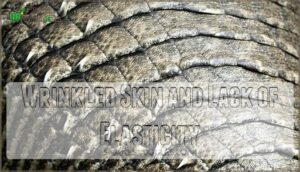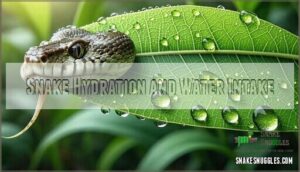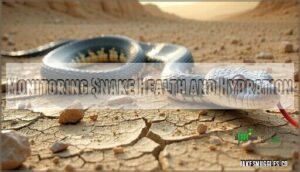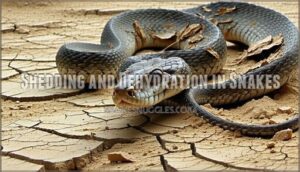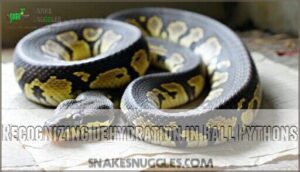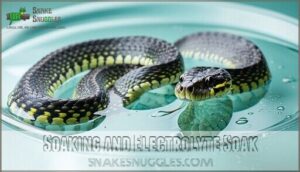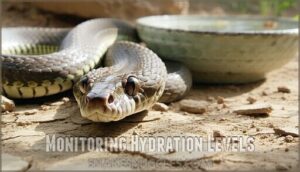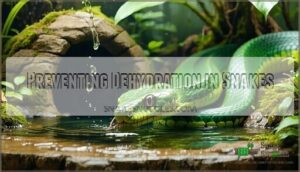This site is supported by our readers. We may earn a commission, at no cost to you, if you purchase through links.
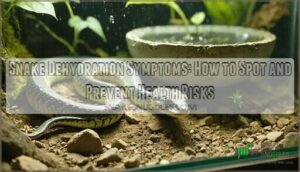
Look for telltale signs like sunken eyes, dry or wrinkled skin, and cracked eye caps.
Your snake might also struggle with shedding, showing patches of retained skin, or appear lethargic and less active than usual.
Dehydration can leave their scales dull and less elastic, making them look unwell.
Causes include insufficient water, low humidity, or underlying illnesses.
Keep an eye on their behavior and environment—small changes can hint at bigger problems.
Proper hydration isn’t just a luxury; it’s imperative for their survival.
Understanding these signs helps you act before it’s too late, and early detection is crucial for preventing severe dehydration.
Table Of Contents
- Key Takeaways
- Identifying Dehydration Symptoms
- Causes of Dehydration in Snakes
- Environmental Factors Affecting Hydration
- Snake Hydration and Water Intake
- Health Risks Associated With Dehydration
- Monitoring Snake Health and Hydration
- Shedding and Dehydration in Snakes
- Recognizing Dehydration in Ball Pythons
- Rehydrating a Dehydrated Snake
- Preventing Dehydration in Snakes
- Frequently Asked Questions (FAQs)
- How do I tell if my snake is dehydrated?
- How do I rehydrate my snake?
- How to treat dehydration in snakes?
- How do you know if a snake is dehydrated?
- What are the 7 signs of dehydration?
- Is a dehydrated snake a problem?
- Do snakes eat if they are dehydrated?
- How to assess dehydration in snakes?
- How do you treat dehydration in reptiles?
- How often should I change my snakes water?
- Conclusion
Key Takeaways
- Check for sunken eyes, wrinkled skin, and dry scales—these are clear signs your snake might be dehydrated.
- Keep enclosure humidity at ideal levels, provide fresh water daily, and consider soaking to prevent dehydration.
- If your snake struggles with shedding or looks lethargic, it’s likely a hydration issue—act fast with proper care.
- Monitor behavior and appearance regularly because dehydration can lead to serious health risks like kidney failure or shedding problems.
Identifying Dehydration Symptoms
When your snake shows signs like sunken eyes, dry skin, or trouble shedding, it’s often a signal of dehydration.
Recognizing these symptoms early can help you address the issue before it becomes a serious health risk.
Sunken Eyes and Dry Skin
Sunken eyes and dry skin are clear signs your snake might be dehydrated.
Sunken eyes and dry skin often signal dehydration—act fast with fresh water and proper humidity to restore your snake’s health.
You’ll notice reduced skin elasticity and dull, cracked scales.
Hydration assessment is paramount—check for changes in eye appearance, scale condition, or behavior.
A sunken eyes snake often lacks proper humidity, causing snake skin turgor issues like wrinkled skin.
Act quickly—provide water and guarantee correct enclosure humidity to address the dehydration issue, ensuring the snake’s skin and overall health improve, with proper humidity being crucial.
Wrinkled Skin and Lack of Elasticity
Wrinkled skin in snakes often signals dehydration and can’t be ignored. If their skin resembles crumpled fabric and folds don’t snap back after pinching, it shows a lack of skin elasticity.
Here’s how you can assess dehydration:
- Perform a skin elasticity test—notice the tenting duration impact when pinched.
- Observe scale appearance changes, like wrinkles or dullness.
- Pay attention to wrinkle depth analysis, as deeper folds often indicate severe dehydration.
Adjusting humidity levels and monitoring skin turgor regularly helps prevent this issue.
Dry Eyes and Cracked Eye Caps
When your snake’s eyes look dull or cloudy, it might be a sign of dehydration.
Dry eyes and cracked eye caps, also called retained eye caps, are classic snake dehydration symptoms.
Watch for these common eye symptoms:
- Cloudy eye cause, like dehydration or low humidity
- Retained eye caps from improper shedding
- Reduced eye turgor making eyes appear sunken
- Dull, flaky eye surface
- Signs of possible infections
Preventing eye issues means maintaining proper humidity, ensuring freshwater availability, and monitoring your snake’s health regularly.
Difficulty Shedding and Lethargy
Poor shedding and lethargy can be telltale snake dehydration symptoms.
When stuck shedding occurs, low humidity is often the culprit.
If your snake appears weak or sluggish, it might be battling dehydration or inactivity risks linked to stress.
Keep your snake’s energy levels up by boosting enclosure humidity and ensuring access to fresh water.
Shedding difficulties are also worsened by improper shedding frequency or dry enclosure environments.
For severe lethargy causes, consult a reptile vet to rule out health problems.
Address these issues quickly to prevent further discomfort and help your snake thrive, ensuring a healthy environment to avoid stress.
Causes of Dehydration in Snakes
Dehydration in snakes often happens when they don’t have enough access to water or their enclosure’s humidity levels are too low.
Illnesses like respiratory infections or parasites can also lead to significant fluid loss, which is a key factor in dehydration.
Lack of Water and Incorrect Humidity
Water availability and proper enclosure design are key to avoiding snake dehydration.
Without access to clean water or sufficient humidity levels, snakes struggle to maintain essential body functions like shedding and digestion.
Make sure humidity gradients in the enclosure match your species’ needs, and adjust misting frequency as needed.
- Common risks in low humidity environments:
- Inadequate water supply
- Insufficient humidity causing shedding issues
- Improper enclosure design
- Lack of consistent misting
- Overlooked species differences requiring specific conditions
Illness and Parasites
When illnesses or parasites strike, you’ll notice snake dehydration symptoms.
Parasite-caused diarrhea leads to rapid fluid loss, making hydration critical.
Watch for signs like:
- Lethargy – your snake seeming sluggish or weak.
- Sunken eyes – often tied to respiratory dehydration.
- Sticky mucous membranes – a sign of infection severity.
- Odd behaviors – stress-induced dehydration may worsen symptoms.
Prompt veterinary intervention prevents lasting harm.
Respiratory Infections
Respiratory infections, like bacterial pneumonia, fungal infections, or those from a viral etiology, can leave your snake struggling to breathe and fighting dehydration.
These infections limit normal hydration, as sick snakes often drink less and lose fluids through stressed respiration.
Snake dehydration symptoms include lethargy, sunken eyes, or sagging skin, and untreated respiratory infections worsen them.
Antibiotic treatment or nebulization therapy can combat these snake health issues.
Keep humidity at a desirable level and watch for signs of snake illness to safeguard hydration and overall well-being.
Ensure the snake’s environment supports recovery by maintaining appropriate conditions, and be aware of the signs of dehydration and respiratory infections to act promptly.
Environmental Factors Affecting Hydration
You play a key role in managing your snake’s hydration by maintaining proper enclosure conditions.
Factors like temperature, humidity, and habitat design directly influence their water needs and overall health.
Temperature and Humidity Settings
Getting the temperature and humidity right in your snake’s enclosure is vital.
Use temperature gradients to mimic their natural habitat, from warm basking areas to cooler spots.
Regular humidity monitoring helps guarantee the levels meet species requirements.
Consider the enclosure size and seasonal adjustments, as larger setups may demand different care.
A well-planned snake enclosure setup helps maintain proper snake environmental control, ensuring your pet stays comfortable and hydrated.
Dry or Hot Environments
A dry or arid climate creates unique challenges for desert enclosures.
To prevent snake dehydration symptoms, focus on proper environmental control:
- Provide Shade: Include hides or shaded areas to escape heat from basking spots or heat lamps.
- Ensure Ventilation: Good airflow prevents stale, overly dry air.
- Monitor Humidity: Even desert snakes need balanced humidity levels to stay hydrated and healthy.
Consider using a reptile humidifier system to maintain proper humidity.
Habitat and Natural Environment
To keep your snake healthy, the enclosure should reflect their natural environment.
Whether they thrive in a rainforest or an arid climate, focus on proper enclosure mimicry, starting with substrate like coconut fiber.
Maintain natural humidity by monitoring humidity levels and adding hydration sources, such as water bowls.
Environmental enrichment, like plants and hiding spots, promotes comfort.
Regular misting enhances environmental humidity and prevents dehydration.
A spacious setup allows self-regulation, keeping your snake’s habitat aligned with their species’ specific needs.
Snakes use burrowing behaviors to regulate temperature and find shelter, which is an important part of their natural environment and overall health, ensuring their comfort.
Snake Hydration and Water Intake
Keeping your snake properly hydrated means understanding how they take in water and use it to stay healthy.
From drinking directly to absorbing moisture through their environment, hydration is essential for their survival and overall well-being.
Time Without Water and Survival Rates
Snake survival times without water vary by species.
Some tolerate weeks, while others risk dehydration within days.
Desert snakes’ water survival often exceeds their tropical counterparts, thanks to adaptations.
Monitor hydration thresholds carefully, as individual needs differ.
Snake dehydration symptoms—sunken eyes, wrinkled skin—can escalate quickly.
Recovery potential improves with prompt care, so control environmental impact and check dehydration timelines regularly to keep snakes healthy.
Some desert species exhibit remarkable survival skills, enduring up to 200 days without water, which is a testament to their desert adaptations and ability to survive with minimal water.
Water Intake From Prey and Environment
Snakes rely on prey moisture and environmental humidity to stay hydrated.
Many species, like desert snakes, draw most of their water intake from prey, reflecting their natural habitats.
Drinking habits also vary—some snakes rarely drink directly but absorb water through their environment.
Maintaining snake proper hydration means replicating species-specific snake humidity levels and ensuring the snake environment supports their unique needs.
Importance of Moisture for Cooling
Moisture plays a big part in how snakes manage heat—think of it as nature’s air conditioning. While they can’t sweat, snakes rely on evaporative cooling and proper humidity gradients.
Providing clean water and maintaining ideal snake humidity levels prevents snake dehydration symptoms like lethargy.
- Offer clean, fresh water daily.
- Create a humid hide for cooling.
- Watch for behavioral adaptations like frequent soaking.
- Adjust enclosure humidity regularly.
- Understand your snake’s species variation needs.
Health Risks Associated With Dehydration
When your snake is dehydrated, it faces serious health risks like kidney failure and digestive issues.
Prolonged dehydration can also lead to heat stroke or organ damage, threatening its overall well-being.
Kidney Failure and Digestive Problems
Dehydration isn’t just about thirst—it can wreak havoc on kidney function and digestion.
Kidney failure often causes toxin buildup, impacting overall health. Watch for digestive impaction, appetite loss, or urate buildup, which may indicate trouble.
Reduced urination and constipation signal serious issues. Frequent hydration checks help prevent organ damage and manage snake dehydration symptoms before kidney failure or digestive problems worsen, which is crucial for maintaining overall health.
Heat Stroke and Organ Failure
Heat stroke is a life-threatening risk for snakes, often caused by severe dehydration.
Without enough water, their organs—kidneys, heart, and more—begin to fail, much like a car running without oil.
Heat stroke signs, such as lethargy, sunken eyes, and rapid breathing, demand immediate attention.
Organ failure types, including snake kidney or heart failure, often follow if dehydration continues unchecked.
Treatment options include hydrating your snake with water soaks or electrolyte solutions.
Prevention strategies focus on maintaining proper humidity and access to water.
Stay vigilant for snake dehydration symptoms to avoid long-term effects like organ damage or death.
- Key Prevention Tips:
- Keep humidity levels steady with misting.
- Use appropriately sized water bowls.
- Avoid overly hot enclosures.
- Check for shedding issues regularly.
- Monitor hydration signs daily.
Monitoring Snake Health and Hydration
You can keep your snake healthy by regularly checking for dehydration signs like dry skin, sunken eyes, or reduced activity.
Pay attention to changes in their skin, scales, and behavior, as these can indicate hydration issues requiring immediate care, such as addressing dehydration signs.
Signs of Dehydration and Lethargy
A lethargic snake isn’t just lazy—it’s often a sign of dehydration.
Look for clear snake dehydration symptoms like sunken eyes, wrinkled skin, or tacky mucous membranes.
Shedding problems, reduced skin elasticity, and low energy levels are common too.
Lethargy causes discomfort and health risks, so act fast.
Proper hydration keeps your snake active and healthy, ensuring their vibrant scales shine and shedding stays smooth.
Abnormal Swellings and Masses
Spotting unusual lumps or swellings on your snake can indicate serious health issues like abscesses or tumors. Acting fast is vital to prevent complications.
During checks, look for:
- Cysts or abnormal growths under the skin.
- Signs of fluid accumulation in swollen areas.
- Scale abnormalities around lumps.
- Any mass interfering with movement.
Quick veterinary care guarantees proper tumor diagnosis or treatment of snake dehydration symptoms linked to swelling. Such issues can arise from bacterial or fungal infections.
Changes in Skin and Scales
Take a close look at your snake’s skin.
Do you notice dry skin, flaky patches, or wrinkled scales?
Check for dull scales, shedding frequency issues, or unusual color changes.
Skin elasticity loss and visible scale texture damage are red flags.
Adjust enclosure humidity with a humid hide, ensuring proper hydration.
Small changes can prevent bigger problems, including issues with hydration.
Shedding and Dehydration in Snakes
Shedding can be a tough process for snakes, especially if they’re dehydrated, as it often leads to retained skin.
By maintaining ideal humidity levels and ensuring proper hydration, you can help your snake shed smoothly and stay healthy.
Difficulty Shedding and Retained Skin
If your snake struggles with shedding, it might be dehydrated.
Snake shedding issues like snake stuck sheds often start with low humidity (Humidity’s Role).
Here’s how to tackle shedding difficulties:
- Manage enclosure conditions—check for stuck shed causes, like dryness.
- Use shedding aid products to help.
- Adjust habitat humidity for snake stuck sheds.
- Seek veterinary intervention for severe snake dysecdysis.
Soaking and Misting for Shedding
Got a snake struggling to shed? A quick soak can work wonders. Use lukewarm water (82-88°F) for 15-30 minutes to help loosen stubborn skin.
Boost snake humidity by misting frequency, adjusting to the species’ needs. For consistent humidity, consider a snake mister system. Adding a humid hide encourages smoother shedding too.
Never pull on stuck skin—it can cause damage.
- Soaking duration: 15-30 minutes.
- Use water at snake-safe water temperature.
- Check your snake during soaking.
- Moderate misting prevents over-humidity.
- Account for species differences!
Hydration and Skin Elasticity
Hydration plays a big role in your snake’s dermal health, particularly their shedding frequency and skin elasticity.
Dehydration reduces turgor pressure, leading to wrinkled skin, dry scales, and visible skin folds. If shedding seems incomplete or patchy, it’s likely due to reduced skin elasticity.
| Symptom | Possible Cause | Solution |
|---|---|---|
| Wrinkled Skin | Low Hydration | Increase Water Access |
| Poor Shedding | Dehydration Impact | Soak Regularly |
| Dry Scales | Insufficient Care | Adjust Humidity Levels |
Keep hydration a priority, as it is crucial for maintaining your snake’s dermal health and preventing issues like dehydration.
Recognizing Dehydration in Ball Pythons
When your ball python shows signs like wrinkled skin, sunken eyes, or lethargy, dehydration might be the culprit.
Recognizing these symptoms early helps you take the right steps to protect your pet’s health.
Visible Ribs and Spine
Visible ribs and spine are key emaciation signs in ball pythons, often linked to snake dehydration symptoms. These signs indicate muscle atrophy and poor body condition.
- Feed regularly to prevent weight loss and skeletal prominence.
- Ensure a balanced diet suited to their needs.
- Monitor body condition carefully.
- Adjust care routines for hydration and nutrition.
Sunken Eyes and Lethargy
Sunken eyes and lethargy in your snake are clear dehydration signs.
A snake with sunken eyes likely suffers from fluid loss, disrupting normal eye appearance.
Lethargy causes reduced activity levels, making your snake less responsive.
To treat, prioritize fresh water, adjust humidity, and observe behavior changes closely.
Recognizing lethargy early keeps your snake hydrated and prevents severe health issues like dehydration or stress-related illnesses.
Cold Body Temperature
If your ball python feels unnaturally cold, it could indicate snake dehydration or thermoregulation failure. A cold body temperature, often tied to metabolic slowdown and reduced circulation, can trigger digestive issues or even brumation effects.
A cold ball python could signal dehydration or metabolic slowdown—check enclosure conditions to prevent digestive issues or brumation complications.
Here’s how to respond:
- Check Enclosure: Verify proper temperatures (75-85°F) and humidity. Low levels exacerbate dehydration symptoms.
- Distinguish Brumation: Recognize normal cooling during brumation versus potential dehydration.
- Gentle Warming: Carefully handle your snake to gently share body heat, aiding thermoregulation.
If symptoms persist, seek snake veterinary care promptly for professional guidance. Ball pythons exhibit shelter seeking behavior when cold, so verify proper heating.
Rehydrating a Dehydrated Snake
If your snake shows signs of dehydration, quick action is essential to restore its health. Providing fresh water, proper humidity, and supportive soaks can help your pet regain hydration safely.
Providing Fresh Water and Humidity
If your snake’s hydration is low, start by making certain water availability with a large enough water bowl for a soak.
Maintain humidity gradients in the enclosure, aiming for steady humidity levels that suit the species. Use misting techniques sparingly to avoid over-saturation.
Always provide fresh water daily, making sure of cleanliness. A humid hide can boost hydration while offering comfort.
Addressing known snake dehydration symptoms early makes certain your pet thrives, keeping its hydration balanced and health on track. Stay vigilant!
Soaking and Electrolyte Soak
A regular soak is a key part of rehydrating a snake, use lukewarm water, verifying the water temperature stays between 82-84°F, so your snake stays comfortable.
For enhanced hydration, try an electrolyte soak by mixing a proper solution concentration as outlined in the snake electrolyte formula.
Aim for a soak duration of 15-20 minutes, repeated two to three times weekly, and always monitor your snake closely during soaking to guarantee a safe, stress-free experience, as the electrolyte benefits include faster rehydration and healthier shedding.
Monitoring Hydration Levels
Keeping an eye on your snake’s hydration is all about paying attention.
Weight tracking can reveal sudden changes signaling trouble. Check skin elasticity—snakes should bounce back, not sag.
Look at eye appearance for clarity, not dryness. Examine urates observation (waste consistency) and watch activity levels; sluggishness might mean dehydration.
Reliable snake reptile care means staying proactive about hydration, as their needs directly affect snake health and well-being.
Preventing Dehydration in Snakes
You can prevent dehydration in snakes by understanding their specific needs and creating a habitat that mimics their natural environment.
Maintain proper humidity, provide clean water, and include a humid hide when necessary to keep your snake healthy and hydrated.
Researching Snake-Specific Needs
Understanding your snake’s species-specific needs is key to keeping them healthy and hydrated.
Each species has unique humidity needs, diet moisture content, and enclosure size impacts.
Research your snake’s natural habitat mimicry to create a proper environment.
For instance, desert species tolerate low water levels, while tropical snakes depend on higher humidity.
Monitor temperature gradients and make certain their diet meets hydration demands.
Knowing snake species needs helps you detect snake dehydration symptoms and meet their long-term hydration needs effectively.
Maintaining Proper Temperature and Humidity
Creating a healthy habitat begins with understanding snake temperature requirements and snake humidity requirements, which vary by species.
Use thermometers to maintain temperature gradients, ensuring your snake can regulate its body temperature.
Humidity monitoring is equally critical; adjusting for seasonal changes keeps hydration in check.
Proper enclosure ventilation prevents dryness while supporting humidity levels.
Tailor these settings to your snake’s needs, focusing on every detail to avoid snake dehydration and maintain health.
Providing a Humid Hide and Clean Water
A humid hide is a must-have for maintaining proper humidity levels and preventing snake dehydration symptoms.
Create one easily using a plastic box and moss. Place it in a calm, warm area your snake prefers.
You can even purchase a pre-made snake hide for convenience.
A reliable water source variety is essential—clean water bowls or a snake water bowl should always be available.
Remember to clean water bowls regularly to avoid bacteria buildup.
Proper hide material choices and location considerations reduce stress, keeping your snake hydrated and healthy for smooth shedding and vibrant skin.
Frequently Asked Questions (FAQs)
How do I tell if my snake is dehydrated?
An ounce of prevention is worth a pound of cure.
Look for wrinkled skin, sunken eyes, dry scales, weak shedding, or a lack of energy.
These signs suggest your snake may be dehydrated.
How do I rehydrate my snake?
To rehydrate your snake, soak it in lukewarm water for 15-20 minutes daily, adjust enclosure humidity, and provide fresh, clean water.
For persistent dehydration, consider electrolyte soaks or consult an experienced reptile veterinarian.
How to treat dehydration in snakes?
To treat snake dehydration, make certain consistent access to fresh water, soak it in lukewarm water daily for 15-30 minutes, adjust enclosure humidity, and consider electrolyte soaks.
Consult a reptile vet for severe cases.
How do you know if a snake is dehydrated?
Did you know dehydrated snakes often show wrinkled or saggy skin that doesn’t snap back when pinched?
Watch for sunken eyes, flaky skin, or stuck sheds, which are key signs your snake needs help.
What are the 7 signs of dehydration?
Wrinkled, loose skin, sunken eyes, and difficulty shedding are key dehydration signs.
Watch for lethargy, dry or sticky mouth membranes, and dull scales.
These symptoms suggest your snake needs immediate hydration and better habitat care.
Is a dehydrated snake a problem?
A dehydrated snake is a serious issue.
Without proper hydration, their health can spiral, causing lethargy, shedding problems, or worse.
Always maintain their enclosure’s humidity, offer fresh water, and monitor for early warning signs.
Do snakes eat if they are dehydrated?
If a snake is dehydrated, it often refuses to eat.
Dehydration impacts their digestion and appetite, making food unappealing or difficult to process.
Ensuring proper hydration first can encourage them to start eating again.
How to assess dehydration in snakes?
Pinch their skin gently; if it doesn’t snap back, they’re likely dehydrated.
Check for sunken eyes, dry scales, or shedding issues.
Examine behavior—lethargy or refusal to eat can signal dehydration too.
How do you treat dehydration in reptiles?
Picture a parched desert.
To treat reptile dehydration, give fresh water, soak them in lukewarm water daily, boost enclosure humidity, and consult a vet for severe cases.
Adjust care to match their species’ needs.
How often should I change my snakes water?
You should change your snake’s water every day to keep it fresh and clean.
Dirty water can breed bacteria, which isn’t safe for your snake.
Always check for spills or contamination throughout the day.
Conclusion
Caring for your snake doesn’t have to be overwhelming—spotting snake dehydration symptoms early is manageable with the right knowledge.
Watch for signs like sunken eyes, dry or wrinkled skin, and shedding issues.
Maintain proper hydration by maintaining ideal humidity, providing clean water, and monitoring their health regularly.
Small changes in behavior or appearance can signal bigger problems, so stay observant, and prioritize hydration to keep them healthy and thriving, as your snake’s survival depends on proactive care.


